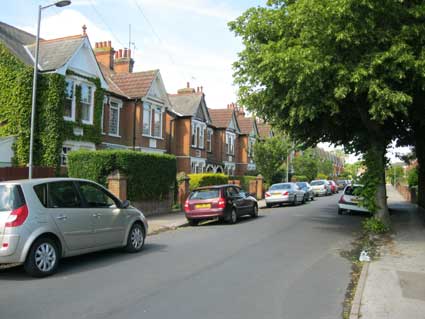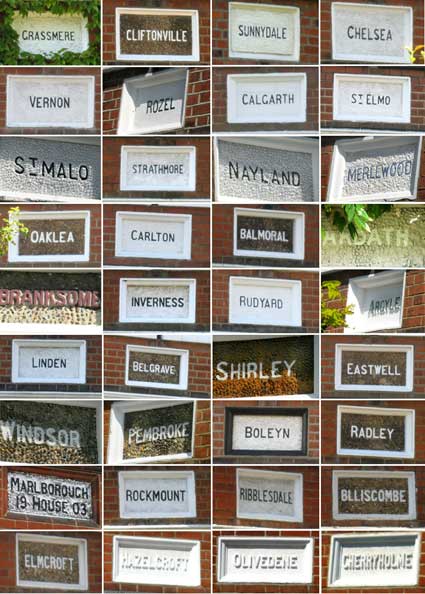Marlborough
Road: a
riot of house names
 2012
images
2012
images
Marlborough
Road is a leafy Edwardian residential
street running from the Cauldwell Hall Road/St Johns Road/Freehold Road
junction down to the rail bridge of Wellesley Road. Many of the gabled
frontages feature a large recessed plaque bearing a house name in large
relief letters. So striking are these, that we thought they deserved a
page on the Ipswich Historic Lettering website.

Notes:
1. the above display of house names reading from left to right includes
all houses except one from the Cauldwell Hall end down to the last
'large-named' house – and the biggest in the street
–
'Marlborough House, 1903';
2. number 26 was the only house where the plaque was obscured by a
luxuriant creeper;
3. adjacent roads also feature similar name plaques: Rockmount to
Elmcroft in the top of St Johns Road and the final three with the
letters painted white in Cauldwell Hall
Road; this suggests that all
were part of the same development.
Let's look at the sources which may have been used by the
developer in naming the houses (bearing in mind that each
name
plaque had to be individually made prior to – or during –
erection.
Grassmere:
not the Lake
District village, which has only one 's'. The name with a double-'s'
appears elsewhere in the UK and worldwide: Grassmere Lake is in the
South Island of New Zealand
Cliftonville:
a coastal area
of Margate in Kent
Sunnydale:
a name used for
companies in the UK and, ironically the town inhabited by Buffy The
Vampire Slayer
Chelsea:
the Royal Borough of
Kensigton & Chelsea, we believe it has a football team
Vernon:
probably named after
Admiral Vernon (known as 'Old Grog'), twice Mayor of Ipswich, and
Admiral of the Fleet when it won a notable victory at Portobello. [UPDATE 24.6.2020:'I’ve been doing
some research recently into Alfred Lyon who lived on Caudwell Hall Road
[Marlborough Road] at Vernon House. Came across your website and saw
mention of some houses on the road and their possible origins,
referring Vernon House to Captain Vernon…. however I wonder if there
maybe another reason? Alfred Lyon had lived in Bloomsbury Square in
London at 1 VERNON PLACE….. so wondered if it was him that christened
the house? Great website, though. Mark Keable.']
Rozel:
possibly named after Le
Rozel, Manche, Basse-Normandie, France
Calgarth:
the Calgarth estate
in Troutbeck Bridge , Windermere , Westmoreland
St
Elmo: Erasmus of Formiae
(Saint Elmo), the patron saint of sailors
St
Malo: a walled port city in
Brittany in northwestern France on the English Channel
Strathmore:
name given to a
number of places in Scotland
Nayland:
a village in the
Stour Valley on the Suffolk side of the border between Suffolk and Essex
Merlewood:
a name used by a
number of companies in the UK
Oaklea:
no specific
derivation; a 'typical' house name
Carlton:
the name of several
UK places, notably a small village near Saxmundham, Suffolk
Balmoral:
Balmoral Castle, a
residence of Queen Elizabeth II in Aberdeenshire, Scotland
Ardath:
title of a novel by
Marie Corelli, published 1889
Branksome:
name of places in
C. Durham and Dorset
Inverness:
Scottish city at
the mouth of the River Ness
Rudyard:
a lake in
Staffordshire and the first name of Rudyard Kipling, author
Argyle:
an archaic spelling of
Argyll, a region of Western Scotland
Linden:
one of three English
names for the tree genus Tilia (also known as lime and basswood)
Belgrave:
the name of a
square, one of the grandest and largest 19th century squares in London
– the centrepiece of Belgravia; also a village in Cheshire
Shirley:
the name of several
UK places
Eastwell:
name of places in
Leicestershire and Kent
Windsor:
Windsor, Berkshire,
on the western outskirts of London; site of the royal Windsor Castle
and the given name of the present royal family
Pembroke: town in west
Pembrokeshire, Wales; also The Earl of Pembroke
Boleyn: most famously Anne
Boleyn, Queen of England from 1533 to 1536
as the second wife of Henry VIII
Radlet: a small place in
Somerset, not the affluent in Hertfordshire
which has a double-'t'
Marlborough (House): town in
Wiltshire, best known for its public
school; also The Duke Of Marlborough
Rockmount: no specific
derivation; a 'typical' house name
Ribblesdale:
the River Ribble is a river that runs
through North Yorkshire (Ribblesdale) and Lancashire
Blliscombe: what a strange
double-'l' – is this a mis-spelling? – no derivation found
Elmcroft: no specific
derivation; a 'typical' house name (later to be used as the name of a
road in 'The Crofts' in the White House/Castle Hill area)
Hazelcroft: no specific
derivation; a 'typical' house name (see note for Elmcroft)
Olivedene: no specific
derivation; a 'typical' house name
Cherryholme: no specific
derivation; a 'typical' house name
[If you know any different, let us know.]
One theory about the naming of these houses is that, as each one was
nearing completion, the developer asked those building it what they
would like to call it. The only slight flaw in this theory is that he,
the developer, would then have to commission name tablets – all on
different timescales. It's possible, though... Another thought is that
the names refer to battles fought by The Suffolk Regiment, but it seems
they didn't fight (m)any battles and the Marlborough Road house names
don't relate to the places where they were stationed.
The Borough's local list tells us about one of these buildings:
"14 Marlborough Road. 1911. Architect: JA Sherman. 2 storey gabled
detached house. T-shaped plan, projecting wing to rear. Red brick
ground floor, painted render at first floor level. 3 bay street
frontage with projecting central bay under a gable. The glazed front
door (decorative leaded light) is in this bay, under a flat canopy
supported on timber brackets and set between narrow rectangular hall
windows.
Either side, at ground floor level, flat roofed bay windows. A
prominent string course separates the upper floor; in the central bay
this becomes a projection supported on shallow brick brackets. Upper
floor windows are simple mullioned openings with shallow label
mouldings below the cills. Above the central window, in the gable, a
blank frame moulding with labels. 2 chimneys. Red brick garden wall."
Marlborough Road is opposite The Lion's Head
public house and the dated 'AD 1900' shop at 121 Cauldwell Hall Road.
Related pages:
House
name plaque examples: Alston Road;
Bramford Road; Broomhill Road; Burlington Road;
Cauldwell Hall Road; Cavendish Street; Rosehill area;
Ipswich & Suffolk Freehold Land
Society (F.L.S.); California
Street index; Origins of street names
in Ipswich; Streets named after slavery
abolitionists.
Dated buildings list; Dated buildings examples;
Named
buildings list;
Named (& sometimes dated) buildings
examples.
Street nameplate examples; Brickyards
Home
Please email any comments and contributions by clicking here.
Search Ipswich
Historic Lettering
©2004 Copyright
throughout the Ipswich
Historic Lettering site: Borin Van Loon
No reproduction of text or images without express written permission
 2012
images
2012
images